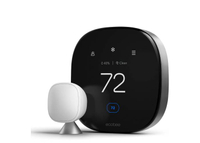Best DIY home security systems
The best DIY home security systems are easy to install, include motion and entry sensors, a loud siren and professional monitoring, all for a reasonable monthly fee.
The best DIY home security systems offer the safety and reassurance of a professionally installed security system, but for less — but there's a little more work required on your end.
Over the years, we've tested a number of DIY home security systems in our own homes, seeing how easy they were to install — things have become a lot easier in recent years — how easy they were to use, and how much they cost, both in terms of the equipment and the monthly or annual costs for professional monitoring.
Our favorite DIY home security system is Abode; the company offers a diverse set of hardware — including an all-in-one system — and works with a huge array of smart home devices, making it easier to add to a house that already has smart locks, smart lights, video doorbells, and more. And, while its professional monitoring fees aren't the least expensive of the services we tested — Wyze ranks number one for that — they're not the priciest, either.
Read on to find out where each of the best DIY security systems excels.
The best DIY home security systems today
Why you can trust Tom's Guide
Best overall
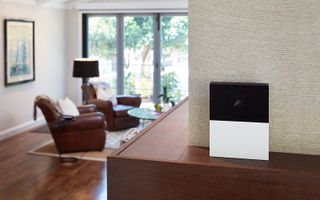
1. Abode
Our expert review:
Specifications
Reasons to buy
Reasons to avoid
Whether you're a first timer to smart security or a seasoned veteran in the world of automation, the Abode Essentials Starter Kit has something for everyone, which is why we think it's the best DIY security system overall. In addition to being a versatile smart home controller with both Zigbee and Z-Wave integration — which means you can use it to control things like smart bulbs and smart locks — it's also straightforward to set up. Abode's system can also be connected to Google Home, Alexa, and Apple's HomeKit.
The beginner's bundle is a bit slim in its accessory offerings — you get just the hub, one door/window sensor, one motion sensor, and a key fob — but you can choose from a host of other packages and purchase additional sensors separately.
Abode offers three tiers of service: Free, Standard ($69/year), and Pro ($229/year). The free plan does not let you record video from cameras or use automations within the system, but you can view live video, use smart home integrations, and get push notifications.
The Standard Plan gets you 10 days of rolling cloud storage for video and a timeline of events, such as when doors are opened. The Pro plan gets you 30 days of cloud storage, as well as 24/7 professional monitoring, as well as cellular backup. If you have the Standard plan, you can also get three- and seven-day monitoring on an as-needed basis for $8 and $15, respectively.
Apart from Alexa, Google, and Apple, Abode works with a huge array of smart home devices, including Ecobee, Philips Hue, Schlage, Kwikset, Yale, Leviton, and Sonos.
If you don't need all the smart home integrations, Abode is now offering a less expensive alternative. The Abode Security Kit ($159) works with Alexa and Google Assistant, but doesn't have Zigbee, Z-Wave, or HomeKit compatibility. However, it still will have battery backup, a 4G wireless backup, and a built-in siren. The kit comes with a base station, one motion sensor, and one door/window sensor; you'll be able to add more sensors to the kit.
Best value
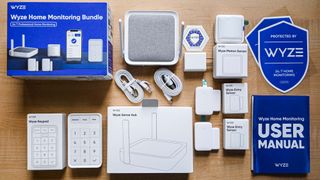
2. Wyze Home Security
Our expert review:
Specifications
Reasons to buy
Reasons to avoid
Wyze has made a name for itself offering quality smart home devices at absurdly low prices, and its Wyze Home Security System is no exception. For $110, the starter kit includes a base station, keypad, motion sensor, and two window/door sensors, one of the lowest prices outside of Ooma. And, adding accessories, such as the Wyze Cam v3, are equally affordable. Moreover, professional monitoring is just $100 per year, far cheaper than the competition.
However, there are a couple of caveats. Unlike all of the other DIY home security systems on this page, Wyze does not have a cellular backup, so if your Internet goes down, so does the system's ability to reach you or a monitor. And it also lacks compatibility with Alexa or Google Assistant. But if you can overlook those issues, it's one heck of a bargain.
Read our full Wyze Home Security System review.
Best professional monitoring
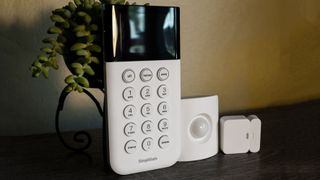
3. SimpliSafe
Our expert review:
Specifications
Reasons to buy
Reasons to avoid
Among the companies that offer professional monitoring, Simplisafe offers several tiers, though they're more expensive than most. However, they all offer cellular and battery backup.
Its basic plan costs $22 per month, while a plan that includes 30 days of cloud storage for video cameras costs $32/month. The Pro Plan ($50/month) adds Active Guard Outdoor Protection from 8 pm to 6 am local time, which uses AI in conjunction with your outdoor cameras to proactively identify potential threats. The Pro Plus plan ($80/month) enables this feature round-the-clock.
In addition to having one of the louder sirens we tested (93 decibels), it's also stylish, and an included keypad makes setting it up accessible for anyone. And, the kit comes with more accessories than the typical bundle from competitors, including three entry sensors instead of the standard one or two. Additional accessories won't break the bank, either, and include a smart lock and a video doorbell, two things you rarely find in DIY home security systems.
Simplisafe integrates with both Alexa and Google Assistant to a limited extent — you can arm, but nor disarm the system — as well as August, which makes what we consider to be the best smart lock.
Read our full Simplisafe Essentials review.
Best cameras
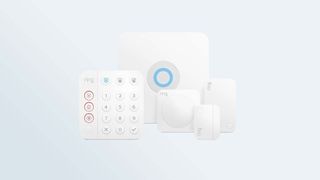
4. Ring Alarm
Our expert review:
Specifications
Reasons to buy
Reasons to avoid
One of the key ingredients to any home security system are security cameras, and you won't get more flexibility or options than with Ring. The company began its existence with video doorbells, and since expanded to home security cameras before moving up to full home security systems. As a result, you can choose from seven Ring video doorbells and as many indoor and outdoor security cameras to add to your system — not to mention smart lights
Ring's Alarm system is affordable, very easy to set up, has a loud alarm, battery and cellular backup. Ring's system is compatible with Alexa, as well as select Schlage, Kwikset, and Yale smart locks, as well as smart plugs, smart light switches, and smart outlets on GE and Leviton. Here is a list of everything that works with Ring.
The second-gen Ring Alarm has smaller door and window sensors, as well as a redesigned keypad with one-touch buttons for Police, Fire, and Medical assistance. The Ring Alarm Security Kit costs $199, and includes a keypad, base station, contact sensor, motion detector, and a range extender. Ring also sells a retrofit alarm kit for $199; if you have a home with existing sensors, it can incorporate those sensors into Ring's system, potentially saving you some money and the hassle of adding new sensors yourself.
Ring also has the Ring Alarm Pro, which has an Eero Wi-Fi 6 mesh router built into the main hub itself. It starts at $299, and also includes 24/7 Internet backup, expandable backup power, local video storage, and Eero Secure, which protects your network from malware and other online threats.
If you want professional monitoring, you'll have to subscribe to Ring Home Standard ($9.99/month) or Premium ($19.99/month), plus an additional $10/month. The Premium plan is also the only one that includes backup Internet, as well as Ring's Smart Video Search, which uses AI to help you more easily find security footage.
Read our full Ring Alarm review.
Best all-in-one system
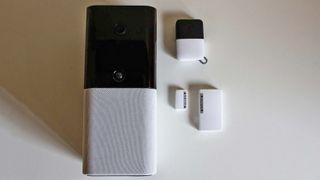
5. Abode iota
Our expert review:
Specifications
Reasons to buy
Reasons to avoid
Most home security systems have a base station that's best left hidden; the Abode iota changes that with a hub that has a built-in 1080p camera, as well as a 93-dB alarm that connects to all its other door and motion sensors and sounds loudly when someone tries to break in. It helps simplify the setup, as you don't need to hook up a separate camera if you don't want. On the other hand, you have to make sure the base station is in a position where its camera is able to adequately cover part of your house.
The iota is also one of the only security systems that works with Apple HomeKit. It's a good idea, but you can't do as much with the camera as you can with standalone wireless security cameras, which limits its effectiveness.
As with its other home security kits, Abode offers three tiers of service: Free, Standard ($69/year), and Pro ($229/year). The free plan does not let you record video from cameras or use automations within the system, but you can view live video, use smart home integrations, and get push notifications.
The Standard Plan gets you 10 days of rolling cloud storage for video and a timeline of events, such as when doors are opened. The Pro plan gets you 30 days of cloud storage, as well as 24/7 professional monitoring, as well as cellular backup. If you have the Standard plan, you can also get three- and seven-day monitoring on an as-needed basis for $8 and $15, respectively.
Read our full Abode iota review.
Easiest setup
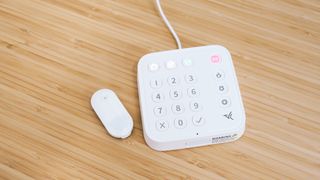
Specifications
Reasons to buy
Reasons to avoid
One of the biggest potential hurdles for anyone installing a DIY home security system is setting up all the sensors correctly. Arlo tries to make this part a lot simpler, as each of its sensors can perform eight different functions: It can act as a window sensor, door sensor, water leak detector, listen for smoke/CO2 alarms, monitor the temperature, light sensor, and freeze detector. Even better - they're not all that large, so you can place them virtually anywhere in your home. The kit we tested comes with two sensors; each additional sensor costs $30.
Using the system itself was just as intuitive. Arlo's app is very easy to understand, and we had no problem setting up routines and other automations. And, if you have Arlo security cameras, you can easily incorporate them into your system.
However, there were a few things that keep Arlo's system from the top of our list. For starters, its professional monitoring costs ($25/month) are the most expensive of the services we tested. And, if you want cellular or battery backup, that's an extra $80 to tack on. For some, though, it could be worth it.
Read our full Arlo Home Security Kit review.
Also tested
Ecobee
While it has the best smart thermostat on the market, Ecobee's home security offering isn't quite up to par with the competition. While we really like the thermostat — which serves as the base station for the system — and its video doorbell, It only offers one security camera, which can only be used indoors. And, there's no power or LTE backup.
We do like its remote sensors, which can also be used in conjunction with the thermostat to keep the temperature in your home at a comfortable level.
Its professional monitoring service isn't the least expensive of the services we tested, but at $10/month or $90/year, it is more affordable than Abode, Ring, and Simplisafe.
Ooma
Ooma started out as a VoIP company, and later offered home security as an add-on. While Ooma's equipment is more or less the same price as the competition — the Ooma Smart Security Starter Pack includes the hub, one motion sensor, and two door/window sensors — Ooma offers the least-expensive professional monitoring, at $14.99 per month.
The company also offers a basic plan for $5.99/month that does not include professional monitoring. Ooma's free tier includes push notifications, unlimited sensors, and a remote siren.
However, Ooma only works with Alexa, and it doesn't have any security cameras. It's also not available in Florida, Virginia, Tennessee, Maryland, Alabama, Arkansas, Rhode Island, Montana, and the District of Columbia.
Read our full Ooma Smart Security review.
How to choose the best DIY home security system
How many doors and entryways do you want to monitor?
Most security kits come with two or three motion and door sensors. However, if you live in a house with a lot of windows, you'll need to add more sensors. Check out how much additional sensors cost; the price can quickly climb.
Key fobs equal convenience
If you have people coming in an out of the house frequently — whether they be dog walkers, house cleaners or annoying family members who happen to live close by — you will want to look at a security system that accepts key fobs or remote access.
Many of the app-first solutions will let you set up individual PIN codes for the different members of your household, while others will include access tags in the box. If this is of particular concern, the Nest Secure is one of the better choices, since even the most technophobic will be okay with merely scanning a keychain every time they exit and enter the house.
Do you want professional monitoring?
How much do you want to spend per month to ensure that your home has that extra protection? In most cases, the bigger the kit and the more devices you're using to monitor your dwellings, the higher the monthly subscription price. (The only system that doesn't do this is the Ooma Home Security kit, though it doesn't offer professional monitoring.) Some companies start as low as $15 a month, like ADT, though they only cover specific triggers. Others can be as high as $30 a month for around-the-clock surveillance. Note that you may also need to register your home alarm with your city or county, which will also add to the overall professional-monitoring fee.
Do you want to make this part of your smart home?
While many security systems will work with such devices as smart locks — unlock your door, and the system will disarm itself — not all integrate as easily with other best smart home devices like security cameras, lights and other sensors. Abode's system is the most compatible in this regard, while Nest's system also does a fair job.
Is the app easy to use?
Consider a security system that comes with an app you'd love to use. You can usually preview these things on the corresponding website. App reviews in the Apple App Store and Google Play Store are also a good indicator of the overall user experience. After all, if you don't have a working portal or gateway to your security system, it's not going to be very functional.
DIY versus professionally installed home security systems
Installing a security system in your home or small business can be an incredibly empowering experience. In the past, if you wanted to protect your home and outfit it with sensors and a siren and the like, you would have had to call a company like ADT, sign up for an annual contract and then wait for someone to come over and configure it all for you. But these days, all you have to do is pick out a kit that suits your security needs.
Perhaps the biggest benefit to setting up your home security system is the fact that you can choose when you want professional monitoring enabled. For instance, if you're the work-from-home type, you might not want a security service, since you're home all the time to see what's going on, anyway. But when you and the family are ready to take a trip away from the abode for several days, you can use an app to enable that additional, watchful eye.
How we test DIY home security systems
We tested out the DIY home security systems in the suburbs of the San Francisco Bay Area in a two-story townhouse over the course of three months. Each kit comes with a base station and a variety of sensors. The security gateways were all configured on the first floor of the house near the main entrance, while the motion sensors were placed facing the front door and were no higher than six feet off the ground. (This was done to test whether each sensor would pick up cat movement.) Additionally, we used a sliding glass door to test each entry sensor.
Most manufacturers list the decibel power of their sirens, but we tested their relative loudness by setting off the alarms and leaving the house. We signed up for every professional monitoring service to check their responsiveness in case of a trigger. Each gateway was also unplugged and used in battery mode to determine its abilities in case of a power outage. If the gateway required an Ethernet connection, it was hooked up to a Google Wi-Fi node that was closest to the front door.
There are some instances when the interface of the system won't rely too much on a mobile app, as is the case with the Samsung SmartThings ADT security kit, which comes with a touch-screen panel, or the SimpliSafe Essentials kit, which comes with a keypad. These are also worth considering if you're not the kind of person who always carries around your phone.
More from Tom's Guide
Sign up to get the BEST of Tom's Guide direct to your inbox.
Get instant access to breaking news, the hottest reviews, great deals and helpful tips.

Michael A. Prospero is the U.S. Editor-in-Chief for Tom’s Guide. He oversees all evergreen content and oversees the Homes, Smart Home, and Fitness/Wearables categories for the site. In his spare time, he also tests out the latest drones, electric scooters, and smart home gadgets, such as video doorbells. Before his tenure at Tom's Guide, he was the Reviews Editor for Laptop Magazine, a reporter at Fast Company, the Times of Trenton, and, many eons back, an intern at George magazine. He received his undergraduate degree from Boston College, where he worked on the campus newspaper The Heights, and then attended the Columbia University school of Journalism. When he’s not testing out the latest running watch, electric scooter, or skiing or training for a marathon, he’s probably using the latest sous vide machine, smoker, or pizza oven, to the delight — or chagrin — of his family.
